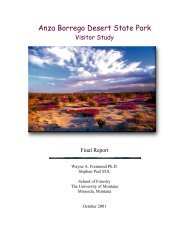Final Mitigated Negative Declaration and Response to Comments
Final Mitigated Negative Declaration and Response to Comments
Final Mitigated Negative Declaration and Response to Comments
Create successful ePaper yourself
Turn your PDF publications into a flip-book with our unique Google optimized e-Paper software.
Fish spawning- Other fish potentially utilizing the project area in Emerald Bay are either nonnative<br />
or not listed as sensitive species, however, covering the substrate with benthic mats<br />
could remove potential spawning habitat during the short term. The mouth of Emerald Bay<br />
receives high boat use <strong>and</strong> associated wake <strong>and</strong> wave action which reduces the suitability of<br />
the area for spawning. AC can reduce food for fish by filtering plank<strong>to</strong>nic plants <strong>and</strong> animals<br />
out of the water column, which many species of fish, especially when young, depend on for<br />
growth. Treatment of the AC infestation area would result in a less than significant short term<br />
impact, with potentially substantial long term gains as fish do not have <strong>to</strong> compete locally with<br />
AC for the plank<strong>to</strong>n-based food source upon which they depend.<br />
Sensitive Natural Plant Communities<br />
Sensitive plant communities are regionally uncommon or unique, unusually diverse, or of<br />
special concern <strong>to</strong> local, state, <strong>and</strong> federal agencies. Removal or substantial degradation of<br />
these plant communities constitutes a significant adverse impact under CEQA. A search of the<br />
CNDDB did not show any sensitive natural plant communities near the project area (CNDDB<br />
2009), but the deep water plant communities in Lake Tahoe are of concern because they are<br />
important ecological components in Lake Tahoe <strong>and</strong> have experienced substantial long term<br />
declines. These plant communities consist of mosses, liverworts, s<strong>to</strong>neworts, <strong>and</strong> algae <strong>and</strong><br />
are typically found at depths greater than 200 feet. Control activities will occur in waters<br />
generally less than 30 feet deep <strong>and</strong> research has also indicated that AC may be able <strong>to</strong><br />
impact the algal biomass in the lake lit<strong>to</strong>ral zone <strong>and</strong> cause local decreases in the algal<br />
biomass in near shore areas, while also stimulating the growth of undesirable filamen<strong>to</strong>us<br />
algae (Whittmann et al. 2011). Project activities are not expected <strong>to</strong> impact deep water plant<br />
communities.<br />
Wetl<strong>and</strong>s <strong>and</strong> Waters of the United States<br />
The Federal Clean Water Act (CWA) defines wetl<strong>and</strong>s as l<strong>and</strong>s that are inundated or saturated<br />
by surface or ground water at a frequency <strong>and</strong> duration sufficient <strong>to</strong> support, <strong>and</strong> under normal<br />
circumstances do support, a prevalence of vegetation typically adapted for life in saturated soil<br />
conditions. The U.S. Army Corps of Engineers (USACE) has jurisdictional authority of<br />
wetl<strong>and</strong>s under provisions found in Section 404 of the CWA. Typically, the USACE<br />
jurisdictional wetl<strong>and</strong>s meet three criteria: hydrophytic vegetation, hydric soils, <strong>and</strong> wetl<strong>and</strong><br />
hydrology.<br />
Waters of the U.S. (Other Waters) are regulated by the USACE under Section 404 <strong>and</strong> by the<br />
state water pollution control authority (Lahontan Regional Water Quality Control Board) under<br />
Section 4041 of the CWA. They are defined as all waters used in interstate or foreign<br />
commerce, waters subject <strong>to</strong> the ebb <strong>and</strong> flow of the tide, all interstate waters including<br />
interstate wetl<strong>and</strong>s <strong>and</strong> all other waters such as: intrastate lakes, rivers, streams, mudflats,<br />
s<strong>and</strong>flats, wetl<strong>and</strong>s, sloughs, prairie potholes, wet meadows, playa lakes, <strong>and</strong> natural ponds.<br />
Waters of the U.S. are under the USACE jurisdiction.<br />
Tahoe Regional Planning Agency (TRPA) Goals <strong>and</strong> Policy, Chapter IV: Conservation<br />
Element, Vegetation Goal #2 is <strong>to</strong> “Provide for maintenance <strong>and</strong> res<strong>to</strong>ration of such unique<br />
Asian Clam Control Project IS/MND<br />
Emerald Bay State Park<br />
California Department of Parks <strong>and</strong> Recreation<br />
30
















